Scouts 'NAYLE' the Qualities of Leadership
By Scott Daniels
Photographs by Vince Heptig
A new course at Philmont's Rocky Mountain Scout Camp reinforces Boy Scout leadership methods by focusing on strategies for group success in challenging high adventure activities.
- Why Scoutmasters Should Send Their Scouts to NAYLE
- Register Troop Leaders Now for 2007 NAYLE Courses
- NAYLE Mission Statement
- What Scouts Say About NAYLE
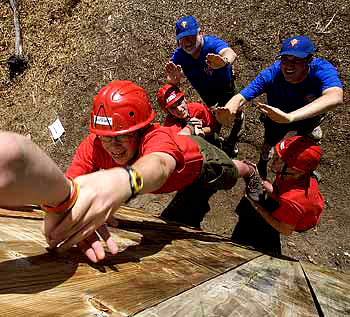 Keith Juricek, right, of the Cimarroncito Patrol, grabs a hand to climb the COPE course wall at Rocky Mountain Scout Camp while fellow Scouts spot him from below. |
The following paragraphs are fiction:
Two Scouts attending a leadership course at Philmont's Rocky Mountain Scout Camp were reported missing Thursday morning after other members of their patrol woke to cook breakfast at about 6 a.m. and could not find them. A search of the campsite failed to locate them.
The last time both boys were seen was at 11 the previous night when they went to bed, so it was presumed the boys had left camp before daylight.
One patrol member mentioned that, while eating ice cream with the two Scouts, Josh and Ryan, at Philmont's trading post, a staff member told them that "seeing the sunrise from...Lovers Leap was an awesome sight, something they definitely shouldn't miss."
From here on, the story is true.
Those were the facts that members of the Anasazi and Cimarroncito Patrols were given during a simulated search-and-rescue mission at last summer's first National Advanced Youth Leadership Experience (NAYLE).
This weeklong leadership course, taught only at Philmont Scout Ranch near Cimarron, N.M., utilized aspects of rugged Philmont ranger training to teach lessons of ethical decision making, conflict resolution, and selfless service.
"NAYLE is the third level of a training continuum for youth leaders," said Bob Longoria, NAYLE coordinator and a member of the Boy Scout national Training Task Force.
"It starts off with Troop Leadership Training [at the unit level] and continues with the council's National Youth Leadership Training (NYLT). NAYLE is designed to enhance the leadership skills that Scouts learned when they went through NYLT."
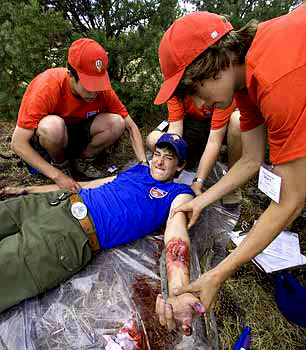 Daniel Thompson, right, and his fellow Rayado Patrol members stabilize "injured" NAYLE staffer Stephen Russ in a simulated wilderness first aid exercise. |
The search begins
And now, back to our story. The members of the Anasazi and Cimarroncito Patrols had learned earlier how to gather information about missing persons, how to narrow a probable search area, and how to look for clues.
Based on the available information, the patrols decided that Lovers Leap, a towering landmark cliff on a popular Philmont trail, was a logical first place to search.
The Scouts kept in contact with staff leaders at the search-and-rescue "incident command center" via two-way radio and called out the boys' names as they hiked up the trail. Near the top, one Scout spied a red NAYLE cap in the steep brushy thicket below the trail. Then they heard cries for help.
"Command, we've located Josh and Ryan. It looks like they may have slipped and fallen down the hillside. Ryan says he thinks he has a broken arm. How should we proceed?"
"Follow the trail to the canyon road and double back to Josh and Ryan," a voice on the radio responded. "If your patrol can safely reach them, assess the injury, treat for shock, and immobilize the arm with a splint. Evacuate to base camp."
A purpose-driven program
Search and rescue was one of seven NAYLE activities the Scouts participated in during their week of leadership development. The others were Project COPE (Challenging Outdoor Personal Experience), wilderness first aid, Leave No Trace, geocaching, conservation, and historical tours of Philmont's Kit Carson Museum and the town of Cimarron.
Each activity contributed to a Scout's understanding of teamwork, legacy, and the course's overall goal of practicing servant leadership. The course ended with an evening commitment ceremony during which each Scout was able to tell how he would use his new leadership skills when he returned home.
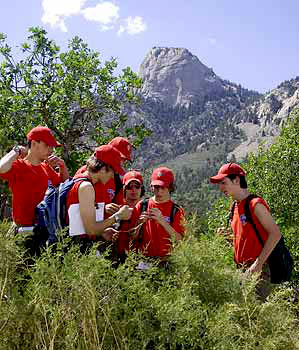 With Philmont's iconic Tooth of Time towering behind them, members of the Miranda Patrol decipher clues in the geocaching event. |
"NAYLE is a conscious effort to help Scouts apply those leadership skills [learned in council-level training] in challenging backcountry scenarios," said Dan Zaccara, NAYLE's task force chairman. It's the ability to take a situation that's new to them and put into practice what they've already learned in their local council, he added.
Keeping a journal was one method Scouts used to reflect on their NAYLE activities. At the beginning of the course, each Scout was presented a rough-hewed, leather-bound journal with waterproof notepaper that resembled something Lewis and Clark might have carried on their westward expedition.
The Scouts were encouraged to write in their journals daily. It could be anything: notes about a new skill, an assessment of a patrol activity, or just a free flow of ideas about what the course meant to them and what they were getting from it.
Midweek, the Scouts left their home base of Rocky Mountain Scout Camp for a hike to Lovers Leap and an overnight camp-out in the meadow beyond. The purpose was a practical lesson in ethical decision making.
"I believe Leave No Trace (LNT) camping is all about [making] ethical decisions," said Zaccara. "Leave No Trace forces a Scout to process: What must I be conscious of? Is this the best thing for the environment? Do I camp on this grass because it's more comfortable, or do I camp on this bare spot because it's already worn and I won't leave any trace?" Zaccara said.
The patrols' campsite selection, coupled with a review of LNT principles, subtly reinforced the right-versus-wrong decision making that is vital to ethical backcountry camping. It's also the same training that staff rangers deliver to every crew that treks on Philmont's property.
The 'Aha! moment'
Dr. Mary Stevens, committee chairman for Troop 84 in San Rafael, Calif., was responsible for NAYLE's geocaching module. Each patrol was given a global positioning system (GPS) unit programmed with coordinates to find small, hidden objects with clues that led to finding the next object. The goal was for all of the patrols to find enough clues to unlock a mysterious prize at the end of the course.
Not surprisingly, and not intended, the geocaching event quickly turned into a race to see which patrol would finish first with all its clues. It created a great teaching moment for problem solving, conflict resolution, and ultimately, the course's primary focus, servant leadership.
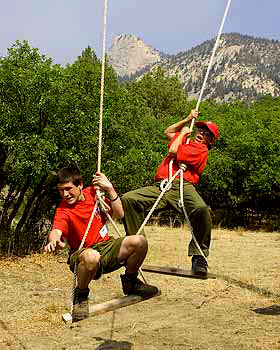 Black Horse Patrol members John Brentin, left, and Cameron Hutton try to move across a set of rope swings in the COPE course Sky Walk. |
Conflicts ranged from "Let me hold the GPS" to "You aren't headed in the right direction," Dr. Stevens said. These types of disagreements don't promote shared leadership and successful teams, she added.
A better solution, Dr. Stevens suggested, would be to inventory the patrol's individual resources ("Has anyone ever used a GPS? What do you think this clue means?") and then capitalize on those contributions to complete the task.
"Conflict resolution is something that [people] face almost every day," said Bob Longoria. It's a great skill to practice but harder to master, unless you believe in and utilize servant leadership, he said.
Dr. Ken King, an assistant Scoutmaster for NAYLE training, put it this way: "A servant leader is the first among equals. He puts the needs of the group ahead of his own needs and sees that the greatest success can be accomplished by people working together."
Near the end of the geocaching activity, most of the patrols returned to a central location, having found all of their clues. One patrol, however, couldn't find its last piece of the puzzle, and without it, none of the patrols could unlock the surprise. The opportunity for blame simmered close to the surface.
And then, almost simultaneously, an "Aha! moment" occurred. The patrols united for the common good and went out together to find the missing link. Once the surprise was unlocked, the success of the hunt was shared by all. In a small way, servant leadership had made the leap from concept to reality.
Legacy and commitment
Throughout the week the importance of legacy was often discussed. It was easy to bring up because Philmont's iconic Tooth of Time mountaintop, framed by the Rocky Mountain Scout Camp's wooden gateway, was a constant reminder of Waite Phillips's gift of Philmont to the Boy Scouts in 1938. "The only things we keep permanently are those we give away," Phillips once said.
The Scouts also toured Philmont's Kit Carson Museum and the small town of Cimarron to find out about Western pioneers who settled in New Mexico and traveled on the nearby Santa Fe Trail.
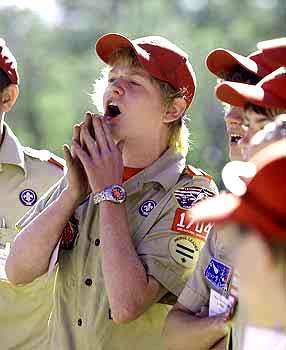 Doug Daniels of Troop 876, Carrollton, Tex., shares his patrol spirit at morning assembly. |
But the Scouts discovered that not all legacies have to be passed down from prior generations: They could leave one themselves. And they did, by beginning a trail-building project from the Lovers Leap turnaround to the nearby stockade.
The late-evening commitment ceremony was NAYLE's final activity. It took place at dusk in the quiet courtyard of the Villa Philmonte, Waite Phillips's Spanish Mediterranean-style mansion on the grounds of the Philmont Training Center.
Everyone stood in a large circle and passed a lantern from person to person. As each Scout held the lantern, he had an opportunity to say what the week had meant to him and how he would keep alive its lessons of servant leadership.
Rich Owens was a NAYLE troop Scoutmaster and remembered the Scouts' sincerity.
"They got it!" he said proudly. "Some of the comments were so mature; it really surprised me. I work for a Fortune 10 company, and I've seen people who've been in business for 30 years who couldn't have stood in that circle and come up with the same comments."
"I was caught off guard," Dr. Ken King acknowledged. Over the course of a week, the Scouts connected the dots, Dr. King said. They were really inspired by their newfound opportunity for servant leadership.
"The typical teenage way to express solidarity is to [do something like] punch a friend in the arm," Dr. King added. But in that circle, "they punched themselves in the heart and were willing to share it."
Scott Daniels is the executive editor of Scouting magazine. He was also a member of the task force that developed the NAYLE curriculum.
Why Scoutmasters Should Send Their Scouts to NAYLE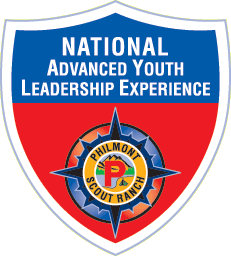
NAYLE Coordinator Bob Longoria says Scouts who attend the Philmont leadership course return to their troops with a commitment to develop other boys into effective leaders. "We are steering people toward a life of leadership service," he says. NAYLE builds upon the skills learned at a local council's NYLT course to a point that they become much more instinctive, intuitive, and not just for Scouting. "The skills taught at NAYLE apply to everything a young man does," Longoria adds, "whether he's at home, at school, or in a meeting with his Scout troop." "I think Scouts will return to their units with a new prospective on leadership," says Dr. Ken King, an assistant Scout-master of a NAYLE troop. "They will have a greater commitment to function as leaders for the good of the troop and for the good of the patrol," the college professor says. "They've learned what it means to be a leader in a variety of new and different situations." —S.D. |
Register Troop Leaders Now for 2007 NAYLE CoursesThe National Advanced Youth Leadership Experience (NAYLE) will run six one-week sessions this summer at Philmont Scout Ranch near Cimarron, N.M. To attend, a Scout must be 14, but not yet 18, have held a troop leadership position, and have completed both Troop Leadership Training and National Youth Leadership Training. The 2007 dates are: June 17-23, June 24-30, June 30-July 6, July 7-13, July 15-21, and July 22-28. Councils may send a council contingent, or troops may send their patrol leaders' council. Scouts may also register individually. Philmont offers concurrent training for contingents of adult leaders during most weeks of the NAYLE course. Cost for the NAYLE program is $305. This fee covers meals, lodging, and training materials. It also provides each Scout a NAYLE cap and two NAYLE T-shirts, which will be worn as part of the official activity uniform during the week. Transportation to Philmont is available from the Albuquerque airport; Raton, N.M., Amtrak station and Greyhound bus depot; and the Cimarron, N.M., bus depot. Prior arrangement for this transportation service is necessary, and additional charges apply. More information, including applications, a promotional PowerPoint presentation, and forum comments from last year's NAYLE participants, is available at www.NAYLE.org. Interested persons may also contact Philmont directly by writing to: Philmont Training Center, Attn: NAYLE Program, 17 Deer Run Rd., Cimarron, NM 87714. Phone: (505) 376-2281, Fax: (505) 376-2636, and E-mail: info@NAYLE.org. —S.D. |
NAYLE Mission StatementThe mission of the National Advanced Youth Leadership Experience (NAYLE) is to provide Scouts with a Philmont-based wilderness encounter that motivates them to follow a life of helping others succeed, based on the values expressed in the Scout Oath and Law. This mission is accomplished by:
|
What Scouts Say About NAYLE"Servant leadership is putting others before yourself and being the 'go-to' guy who is willing to do anything to help out the troop....[When you act as a servant leader,] others will catch on. They'll start helping out more without thinking about it and start using servant leadership skills themselves." —Jack Malone, Troop 21, Edmond, Okla. "My legacy is...that years from now...people are going to remember [that my NAYLE troop helped build] a trail...They will walk on it and know that it was something that Scouts did." —Daniel Thompson, Troop 14, LaGrange, Ill. "What you learn at NAYLE is leadership skills that you can use all of your life...It can help you in Scouting, it can help you in everyday life, and it can help you with school and even your job." —Addison Hendricks, Troop 114, Virginia, Minn "NYLT and NAYLE skills aren't just for Scouting....I use [them] with student government...[and] for school clubs. You can apply these leadership skills with any group of people. It doesn't necessarily have to be Scouting." —David Sill, Troop 32, Hollidaysburg, Pa. "A Scoutmaster's job will probably be a lot easier when a NAYLE Scout returns to his unit. The Scouts from this course will be more mature and able to apply their leadership skills to make the troop run a lot smoother." —Payton Bramlett, NAYLE staff, assistant senior patrol leader "At NYLT, Scouts are given a 'toolbox' of leadership methods. At NAYLE we want to make using those tools second nature, something they can just pull out and apply without having to think about it." —Payton Bramlett, NAYLE staff, assistant senior patrol leader "I just returned from the NAYLE pilot course, and all I can say is 'WOW.' It was such an amazing experience with so much happening in one week. I would highly recommend this course to anyone who would like more leadership skills than what they were taught in NYLT." —posted by a Scout on the forum page at www.NAYLE.org "I had the best time of my life. The Philmont experience made it all come together and made it a once-in-a-lifetime event. It was so much fun to actually use the NAYLE skills and then be able to connect them back to what is taught in NYLT." —posted by a Scout on the forum page at www.NAYLE.org "NYLT gives you leadership skills in more of a classroom setting, whereas with NAYLE...you actually use your leadership skills." —David Sill, Troop 32, Hollidaysburg, Pa. |
March - April 2007 Table of Contents
Copyright © 2007 by the Boy Scouts of America. All rights thereunder reserved; anything appearing in Scouting magazine or on its Web site may not be reprinted either wholly or in part without written permission. Because of freedom given authors, opinions may not reflect official concurrence.